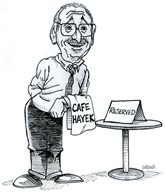David Henderson injects tariffs into Leonard Read’s remarkable pencil. A slice:
Remember that the ✏️ is talking. Hokey? Sure, but it works. A lot of my 30-something military officer students loved it.
“My ‘lead’ itself—it contains no lead at all—is complex. The graphite is mined in Ceylon [Sri Lanka].” Tariff rate: 44%.
“To increase their strength and smoothness the leads are then treated with a hot mixture which includes candelilla wax from Mexico, paraffin wax, and hydrogenated natural fats.” Tariff rate: 25%.
“An ingredient called ‘factice’ is what does the erasing. It is a rubber-like product made by reacting rapeseed oil from the Dutch East Indies [Indonesia] with sulfur chloride.”Tariff rate: 32%.
“The pumice comes from Italy; and the pigment which gives “the plug” its color is cadmium sulfide.” Tariff rate: 20%. Italy is part of the EU and therefore gets the EU tariff rate.
The Editorial Board of the Wall Street Journal explains that “U.S. Tariffs Make Xi Jinping’s Day.” A slice:
What a fabulous change in fortunes for the Chinese leader. Mr. Trump has taken an ax to the economic cords that were binding the rest of the world into an economic and strategic bloc to rival Beijing—and at precisely the moment many countries finally were starting to re-evaluate their economic relationships with China.
In Asia, countries such as Vietnam hoped expanding trade with the U.S. would allow them to wriggle out from under Beijing’s thumb. Not now that Mr. Trump has imposed a 46% tariff on Vietnamese imports. Ditto other countries eager for a relationship with the U.S. to counterbalance Beijing’s influence, such as Thailand (36% tariff), Indonesia (32%) and the Philippines (17%).
Japan and South Korea, crucial U.S. partners in North Asia, were slapped with tariffs of 24% and 25%. Anti-Americanism remains a potent political force in many of these places, and expect the sentiment to grow. Beijing with its giant market is an alternative.
Ditto in Europe, where the 27 countries of the European Union face a 20% tariff and not even the special relationship could spare Britain the baseline 10% tax. The U.S. has devoted years of diplomacy to discouraging European countries from economic overreliance on China. This finally was starting to pay off in greater European skepticism of closer ties with Beijing. Now it’s only a matter of time before the trade missions to China from France, Germany and elsewhere pick up again.
Presidents have used the law to ban imports, freeze assets and impose export controls, but Mr. Trump is the first to impose tariffs under it. Simplified argues that “if the President is permitted to use the IEEPA to bypass the statutory scheme for tariffs, the President will have nearly unlimited authority to commandeer Congress’s power over tariffs.”
Trade laws authorize the President to impose tariffs “only on industries or countries that meet specified criteria, and only under specified conditions, after following specified procedures,” Simplified says. They also “require advance investigations, detailed factual findings, and a close fit between the statutory authority and a tariff’s scope.”
Mr. Trump used IEEPA to bypass such requirements. Simplified argues the tariffs violate the Supreme Court’s major questions doctrine, which requires executive actions that “present a question of ‘vast economic and political significance’” to be “clearly” authorized by Congress.
Simplified cites the Supreme Court’s West Virginia v. EPA (2022) precedent and notes that “When an agency claims to discover in a long-extant statute an unheralded power to regulate ‘a significant portion of the American economy,’ we typically greet its announcement with a measure of skepticism.”
Mr. Trump has arrogated sweeping new powers over trade by invoking a nearly 50-year-old sanctions law. If Mr. Trump gets away with this, Simplified says, a President “would be empowered to declare a national emergency based on some long-running national problem, then impose tariffs purportedly in the name of that emergency.” Think of the next Democratic President imposing tariffs to fight what he’d call a climate “emergency.”
Even before his late-life pivot to freer trade, McKinley had long been a champion of reciprocity, i.e., the bilateral, mutually beneficial reduction of targeted, asymmetrical tariffs. Or, as he put it in his first inaugural address, “the opening up of new markets for the products of our country, by granting concessions to the products of other lands that we need and cannot produce ourselves, and which do not involve any loss of labor to our own people, but tend to increase their employment.”
George Will decries Trump’s fiscal incontinence. A slice:
Trump’s economic agenda, from taxes to tariffs (which are themselves taxes), is variable because he believes in the immediate translation of whims into policy proposals, without an intervening pause for study. (His conversation with a Las Vegas waitress quickly became his proposal to end taxation on tips.) Commerce Secretary Howard Lutnick says Trump suddenly favors eliminating “taxes” on people making less than $150,000 a year — in 2022, about 93 percent of Americans 15 and over.
If Trump is referring only to income taxes, that would mean (according to Jared Dillian, writing for Reason) that only 7 percent of Americans would pay any income taxes. Already, the top 1 percent of earners provide about 40 percent of income tax revenue, and the bottom 50 percent provide about 3 percent.
Progressives want income taxation to be more progressive so the wealthy will pay “their fair share.” Trump is more progressive still, wanting the wealthy to pay everyone else’s share, too.



